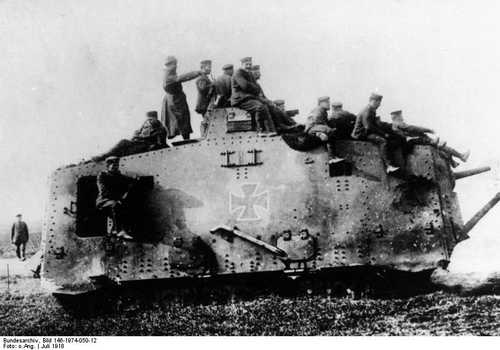
German Armored Forces & Vehicles
The first panzer.
Bundesarchiv./Tank Museum, Munster
A bit off-topic perhaps; I offer the excuse that Sepp Dietrich's first acquaintance with tanks came when he helped crew one of these as a member of Sturmpanzerwagen-Abteilung 15 in WW1. This is a rare 'photo of a Sturmpanzerwagen A7V on the move - rare because they were not very good at moving. This approximated to the early model of a tank as a "land ship" more than British prototypes actually called that. It weighed 33,500 kg - not that much more than British heavy tanks of the period weighing in at about 29,000 kg. However, it was painfully slow (perhaps 8 mph on road, if you were lucky; off-road performance was terrible), underpowered, clumsy, unreliable and difficult to deploy. Armament varied, but typically would be one 57mm body-mounted artillery cannon and six machine-guns. Crew was a staggering 18, composed of a mixed force of Army and Navy personnel. Only 20 examples were produced; the German Sturmpanzerwagen-Abteilung generally relied on captured Allied tanks. At least one tank-to-tank combat between these vehicles and British tanks is recorded. In this, a single AV 7 pressed a pair of "female" British heavies (i.e. armed only with machine guns) until it was in turn driven off by a British "male" tank (armed with two 6-pounder guns) arriving late on the scene. Given that the road speed of the British tanks (and, proportionately, their off-road speed) would have been even slower than that of the AV 7, it is surprising that either party was capable of driving the other anywhere. I suppose that it took some vision for people like Guderian to see the great future that awaited the successors of vehicles like this ... Best regards, JR.
3842 Views
1/21/2011
